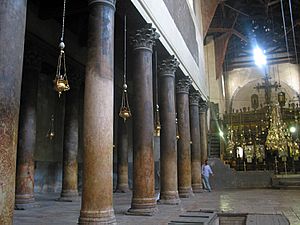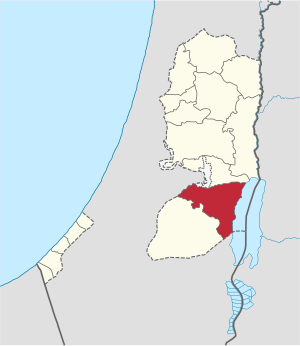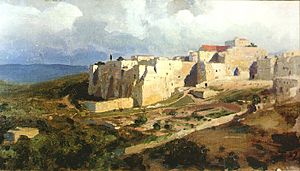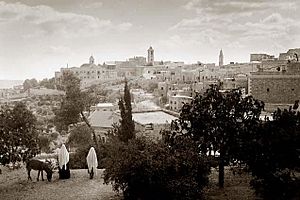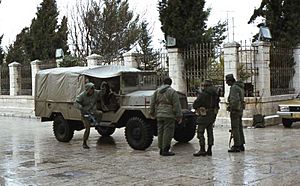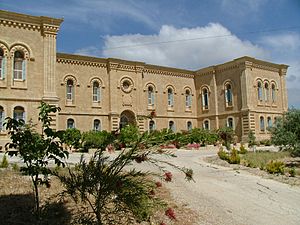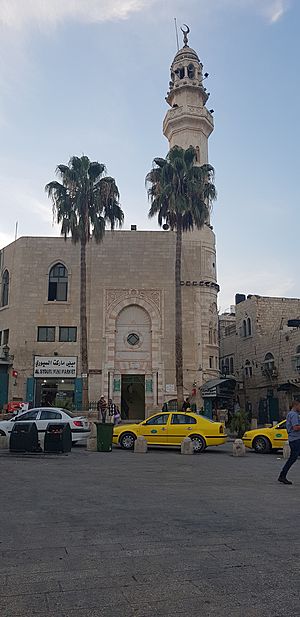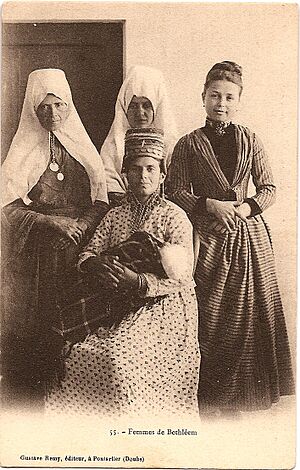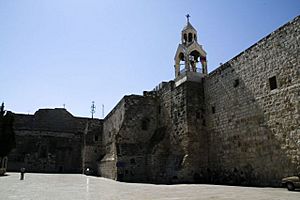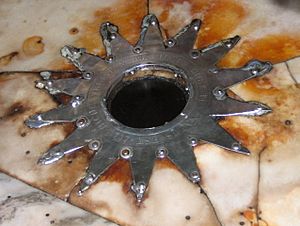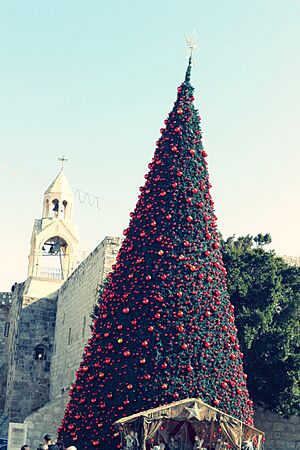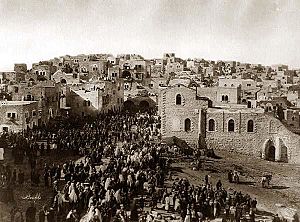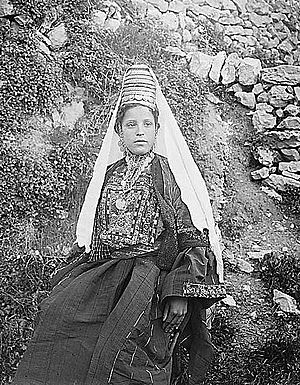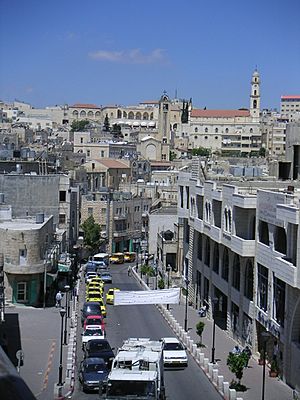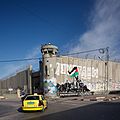Bethlehem facts for kids
Bethlehem is a famous city located in the West Bank. It is known worldwide as the place where Jesus was born. The city is about five miles (8 kilometers) from Jerusalem in Israel.
Today, most people in Bethlehem are Muslims. But it is also home to many Palestinian Christians. The city's main way of making money is through tourism. This is especially true during the Christmas season. Many Christians visit the Church of the Nativity then, just as they have for almost 2,000 years. Bethlehem has over 30 hotels and 300 workshops that make handmade items. Rachel's Tomb, a very important Jewish holy site, is at the northern entrance of Bethlehem.
Contents
History of Bethlehem
Ancient Times
The first time Bethlehem is mentioned in old writings is around 1400 BCE. This was in letters sent to the Pharaoh of Egypt. These letters talked about a town called "Bit-Lahmi." It was a village that belonged to the king. Some people think this name means "House of Lachama." Lachama was a god of fertility for the ancient Canaanite people.
Archaeologists found a burial ground in Bethlehem from around 2200 BCE to 650 BCE. This shows that people lived there for a very long time.
Israelite and Judean Period
In 2012, archaeologists found a clay seal in Jerusalem. It said, "From the town of Bethlehem to the King." This seal was used to mark goods sent as tax payments. This shows that Bethlehem was an important city in the ancient Kingdom of Judah.
The Bible mentions Bethlehem many times. It is believed to be the same as "Ephrath," which means "fertile." It is also called "Beth-Lehem Judah" and the "City of David." The Bible says that Rachel, an important woman, died and was buried near Bethlehem. Rachel's Tomb is still there today.
Bethlehem was also the home of Jesse, who was the father of King David. David, a famous king of Israel, was anointed (chosen) by the prophet Samuel in Bethlehem.
Roman and Byzantine Times
After a big revolt in 135 CE, the Roman emperor Hadrian built a shrine to the Greek god Adonis in Bethlehem. This was on the site where Christians believed Jesus was born.
Later, in 326 CE, Empress Helena, the mother of Emperor Constantine the Great, visited Bethlehem. She helped rebuild the city. She was also responsible for building the first Church of the Nativity.
In 529 CE, during a revolt, Bethlehem was attacked. Its walls and the Church of the Nativity were destroyed. But Emperor Justinian I ordered them to be rebuilt. In 614 CE, the Persians invaded. A story says they did not destroy the church because they saw the magi (wise men) in a mosaic. The magi were shown wearing Persian clothes.
Middle Ages
In 637 CE, after Jerusalem was captured by Muslim armies, the Caliph Umar promised to protect the Church of the Nativity. A mosque was built next to the church where he prayed.
In 1099, Christian Crusaders captured Bethlehem. They made it stronger and built a new monastery. The Greek Orthodox leaders were replaced by Latin ones. On Christmas Day in 1100, Baldwin I, the first king of Jerusalem, was crowned in Bethlehem.
In 1187, Saladin, a Muslim leader, captured Bethlehem from the Crusaders. The Latin leaders had to leave, and the Greek Orthodox leaders returned. Bethlehem's trade with pilgrims from Europe decreased a lot.
Later, in 1229, Bethlehem was briefly given back to the Crusaders. But it was recaptured by Muslims in 1244. In 1250, the Mamluks took control. They were less tolerant of Christianity. The city walls were torn down in 1263.
Ottoman Era
From 1517, the Ottoman Empire ruled Bethlehem. During this time, the Catholic and Greek Orthodox churches often argued over who controlled the Basilica of the Nativity. By the late 1500s, Bethlehem was one of the largest villages in the area. It had about 1,435 people.
From 1831 to 1841, Egypt ruled Palestine. Bethlehem suffered from an earthquake during this time. The Muslim part of the city was destroyed in 1834. This was because of a conflict with Egyptian troops. In 1841, Bethlehem went back under Ottoman rule. Many people left the city during this time. They faced unemployment, forced military service, and high taxes. Many moved to South America.
Modern Era
From 1920 to 1948, the British ruled Bethlehem. In 1947, the United Nations planned to make Jerusalem and Bethlehem a special international area.
Jordan took control of the city during the 1948 Arab–Israeli War. Many refugees from other areas came to Bethlehem. This changed the city's population. Before, most people were Christian, but after, most became Muslim.
In 1967, Israel captured Bethlehem during the Six-Day War. In 1995, Israel handed the city over to the Palestinian National Authority. This was part of a peace agreement.
Today, Bethlehem is surrounded by roads for Israeli settlers. The Israeli West Bank barrier also cuts Bethlehem off from Jerusalem. This wall is 8 meters high in some places.
Palestinian Control
On December 21, 1995, Israeli troops left Bethlehem. The city then came under the full control of the Palestinian National Authority.
During the Second Intifada (a Palestinian uprising) from 2000 to 2005, Bethlehem's tourism and buildings were damaged. In 2002, there was a big conflict. Israeli forces surrounded the Church of the Nativity. Many Palestinian fighters had taken shelter inside. The siege lasted for 39 days. It ended with an agreement to send 13 of the fighters to other countries.
Geography
Bethlehem is located on hills about 775 meters (2,543 feet) above sea level. It is about 30 meters (98 feet) higher than Jerusalem. The city is in the southern part of the Judaean Mountains.
Bethlehem is about 73 kilometers (45 miles) northeast of Gaza City. It is 75 kilometers (47 miles) west of Amman, Jordan. It is also 59 kilometers (37 miles) southeast of Tel Aviv, Israel. Jerusalem is just 10 kilometers (6 miles) to the north. Nearby towns include Beit Jala and Beit Sahour. The Aida and Azza refugee camps are also within the city limits.
The old city of Bethlehem has eight main areas. These areas are like a mosaic around the Manger Square. Most of these areas are Christian, named after old Arab clans. There is also one Muslim area. The total population of the old city is about 5,000 people.
Climate
Bethlehem has a Mediterranean climate. This means it has hot, dry summers and mild, wet winters. Winter temperatures (mid-December to mid-March) can be cool and rainy. January is the coldest month, with temperatures from 1 to 13 degrees Celsius (33–55 °F). From May to September, the weather is warm and sunny. August is the hottest month, with highs around 30 degrees Celsius (86 °F). Bethlehem gets about 700 millimeters (28 inches) of rain each year. Most of this rain falls between November and January.
Demographics
| Year | Population |
|---|---|
| 1867 | 3,000–4,000 |
| 1945 | 8,820 |
| 1961 | 22,450 |
| 1983 | 16,300 |
| 1997 | 21,930 |
| 2007 | 25,266 |
In the early 1500s, Christians made up about 60% of Bethlehem's population. By the mid-1500s, the number of Christians and Muslims was about equal. In 1867, a visitor said the population was 3,000 to 4,000 people. Most were Christians, with about 300 Muslims.
In 1948, Christians were 85% of the city's population. But by 1967, Muslims were 53.9% and Christians were 46.1%.
In 1997, Bethlehem had a population of 21,670 people. This included 6,570 refugees. In 2007, the population grew to 25,266.
Christian Population
Many Christian families in Bethlehem trace their roots back to ancient Arab clans.
The number of Christians in Bethlehem has been going down over the years. This is mainly because many have moved away. The lower birth rate among Christians also plays a part. In 1947, Christians were 85% of the population. By 1998, this number dropped to 40%.
The mayor of Bethlehem said in 2005 that many people, both Christians and Muslims, are leaving. This is due to stress and a difficult economic situation. But it is more noticeable among Christians because they are already a smaller group. The Palestinian Authority tries to ensure Christians have equal rights.
The Second Intifada also hurt the Christian community. Tourism, which many Christians rely on, decreased a lot. Many Christians own hotels and businesses that serve tourists. Studies show that a lack of jobs and education also caused Christians to leave. Since the Second Intifada, 10% of the Christian population has left the city.
Economy
Shopping is a big part of Bethlehem's economy, especially during Christmas. The city's streets and markets have shops selling Palestinian handicrafts, spices, jewelry, and sweets. Olive wood carvings are very popular with tourists. Other handmade items include ornaments made from mother-of-pearl.
Other industries in Bethlehem include stone cutting, textiles, and furniture. Factories in Bethlehem also make paints, plastics, medicines, and food products like pasta.
Cremisan Wine is a winery run by monks. It was started in 1885. They produce about 700,000 liters of wine each year.
In 2008, Bethlehem hosted the largest economic conference in the Palestinian territories. It aimed to get businesses to invest in the West Bank and Gaza Strip. Over 1.4 billion US dollars were promised for investments.
Tourism
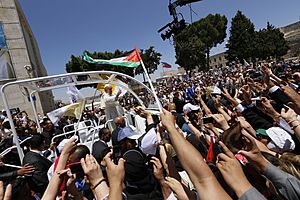
Tourism is the most important industry in Bethlehem. More than 20% of the people who work in Bethlehem are in tourism. It makes up about 65% of the city's economy. Over two million visitors come to Bethlehem every year.
The Church of the Nativity is a major tourist spot. It is a big draw for Christian pilgrims. It stands in the center of the city, in Manger Square. It is built over a cave called the Holy Crypt. This is believed to be where Jesus was born. Nearby is the Milk Grotto, where the Holy Family is said to have hidden. Also, the cave where St. Jerome worked on the Latin Bible is next door.
Bethlehem has over thirty hotels. The Jacir Palace, built in 1910, is one of the oldest and most successful. It closed during a conflict in 2000 but reopened in 2005.
Religious Significance
Birthplace of Jesus
Early Christian stories say that Jesus was born in Bethlehem. The Bible's Book of Micah is seen as a prophecy that the Messiah would be born there. The New Testament has two different stories about Jesus' birth. In the Gospel of Luke, Jesus' parents travel to Bethlehem for a census, and he is born there. In the Gospel of Matthew, it mentions Bethlehem but not the census. It says that King Herod ordered all boys aged two and under in Bethlehem to be killed. This was after hearing a "King of the Jews" was born there. Joseph, warned by an angel, took his family to Egypt. They later settled in Nazareth.
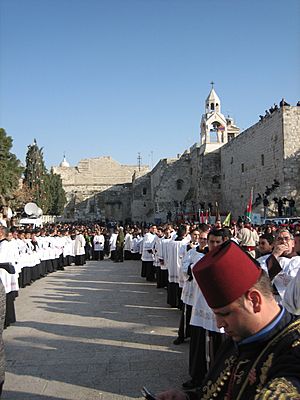
Some modern experts question if Jesus was actually born in Bethlehem. They think the Bible stories might be symbolic. The Gospel of Mark and the Gospel of John do not mention Jesus being born in Bethlehem. They only say he was from Nazareth.
However, early Christian writers like Justin Martyr (around 155 CE) and Origen of Alexandria (around 247 CE) wrote about a cave in Bethlehem. Local people believed this cave was where Jesus was born.
Christmas Celebrations
Christmas is celebrated in Bethlehem on three different dates. December 25 is for Roman Catholic and Protestant Christians. Greek, Coptic, and Syrian Orthodox Christians celebrate on January 6. Armenian Orthodox Christians celebrate on January 19. Most Christmas parades go through Manger Square, which is outside the Church of the Nativity.
Other Religious Festivals
Bethlehem also celebrates other festivals. One is the annual Feast of Saint George on May 5–6. During this time, Greek Orthodox Christians march to the town of al-Khader. They baptize newborns and sacrifice a sheep. The Feast of St. Elijah is also celebrated with a procession to a monastery north of Bethlehem.
Culture
Embroidery
Women in Bethlehem were known for their beautiful bridal clothes. Bethlehem embroidery was famous for its bright colors and shiny metallic threads. Special dresses were made of striped silk. They had a short jacket called a taqsireh. This jacket was often made of velvet and had heavy embroidery.
Bethlehem embroidery was special because it used gold or silver cords. These cords were sewn onto silk, wool, or velvet. They created flower patterns with rounded lines. This style was used for "royal" wedding dresses and head coverings.
Mother-of-Pearl Carving
The art of mother-of-pearl carving has been a tradition in Bethlehem since the 15th century. Franciscan monks from Italy are said to have brought it there. Many pilgrims visiting the city created a demand for these items. This also provided jobs for women.
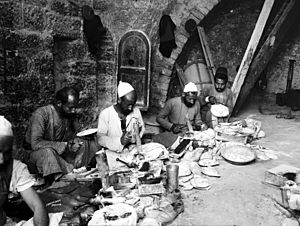
Cultural Centers and Museums
Bethlehem has the Palestinian Heritage Center. It was started in 1991 to protect and share Palestinian embroidery, art, and folklore. The International Center of Bethlehem also focuses on Bethlehem's culture. It offers language training, women's studies, and arts and crafts.
The Bethlehem branch of the Edward Said National Conservatory of Music has about 500 students. It teaches children music and trains music teachers. It also studies Palestinian folk music.
Bethlehem has four museums. The Crib of the Nativity Theatre and Museum shows 3D models of Jesus' life. The Badd Giacaman Museum is about the history of olive oil. The Baituna al-Talhami Museum shows Bethlehem's culture. The International Museum of Nativity was built by UNESCO to show beautiful art.
Local Government
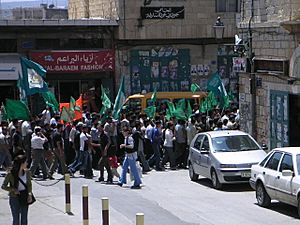
Bethlehem is the capital city of the Bethlehem Governorate.
Bethlehem had its first local elections in 1876. The leaders of the city's old areas decided to elect a council. A rule was made that if the mayor was Catholic, his deputy should be Greek Orthodox.
Today, the Bethlehem Municipal Council has 15 elected members. This includes the mayor and deputy mayor. A special rule says that the mayor and most of the council must be Christian. The other seats are open to anyone.
Different political groups are on the council. These include Communist, Islamist, and other groups. Leftist groups often win the reserved seats. Hamas won most of the open seats in the 2005 elections.
Education
In 1997, about 84% of Bethlehem's people over 10 years old could read and write. Over 10,000 students were in schools. About 14% of high school students earned diplomas. In 2006, there were 135 schools in the Bethlehem area. Most were run by the Palestinian Authority.
Bethlehem is home to Bethlehem University. This is a Catholic Christian university that started in 1973. It is open to students of all faiths. It was the first university in the West Bank.
Transportation
Bethlehem has three bus stations. They offer service to Jerusalem, Beit Jala, and other nearby towns. There are also two taxi stations. Buses and taxis from the West Bank cannot enter Israel without a special permit.
The Israeli West Bank barrier has affected Bethlehem a lot. The wall is on the northern side of the city. It is very close to homes in the 'Aida refugee camp. Most ways in and out of Bethlehem are controlled by Israeli checkpoints. Travel for Palestinians from Bethlehem to Jerusalem needs a permit. Israelis are not allowed to enter Bethlehem.
Twin Towns and Sister Cities
Bethlehem is twinned with many cities around the world. This means they have special friendly relationships.
|
|
Images for kids
-
David, pouring out water drawn from the well of Bethlehem in this 1860 woodcut by Julius Schnorr von Karolsfeld, which illustrates 2 Samuel 23:15–17
-
2018 United Nations map of the area, showing the Israeli occupation arrangements.
-
The Walled Off Hotel, owned and decorated by Banksy
-
Israeli West Bank barrier in Bethlehem in 2012
-
Ceremony in the Church of the Nativity
-
Banksy mural in Bethlehem
See also
 In Spanish: Belén para niños
In Spanish: Belén para niños


